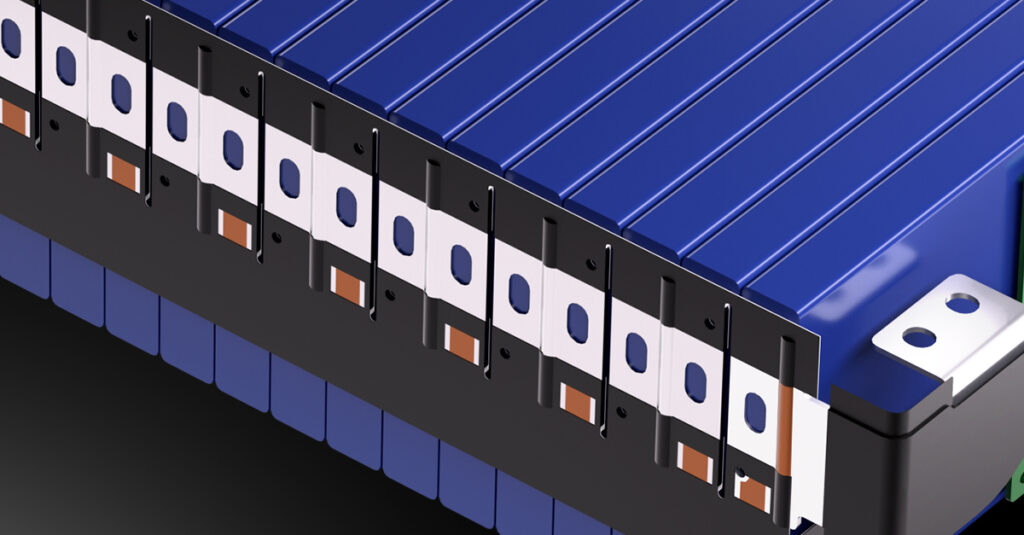As the global market for electric vehicles (EVs) continues to grow and mature, EV makers are looking for improved methods for designing and producing EV batteries, which are typically the largest and most costly element in an EV. Having the ability to choose between the various types of individual cells has become an important factor in giving battery designers more flexibility to serve different regional markets and to optimize options across supply chains for different cell types.

Figure 1 – New technologies to improve cost-efficiency for batteries using prismatic cells.
This article provides a brief overview of the different cell types being used across the world and then drills down with more specific detail on how new technologies are improving cost-efficient assembly of batteries using prismatic cells.
Differences in Battery Cell Types
Three different types of battery cells have become dominant in EV production. These are Cylindrical, Prismatic, and Pouch. While all three types use lithium-ion chemistries, they not only have different design approaches; they also have evolved in different regional markets and are used by different manufacturers around the world.
- Cylindrical – These are made of layered electrodes and separators that are created as flat sheets and then rolled up into the cylindrical shape, which is then enclosed in an aluminum or steel casing. Having evolved from existing cylindrical lithium batteries used for years in non-EV applications they offered initial advantages of leveraging proven mass production methods.
- Prismatic – These rectangular shaped cells consist of layered electrode sheets and separators that are encased in a rectangular metal enclosure. The major advantage is the ability to group rectangular prismatic cells into a battery pack without any gaps between them, which provides higher power density for a given amount of space.
- Pouch – These consist of electrodes and separators with polymer coating and sealed in a flexible aluminum foil casing. Their primary advantage is lighter weight in comparison to other approaches.

Figure 2 – Types of cells for EV batteries.
Prismatic Cells Usage and Market Growth
Rectangular prismatic cells have been manufactured for a few decades, primarily in China, with leading manufacturers such as CATL that has well-established gigafactories producing huge volumes on a continuous basis. In addition to dominating the China market with 85% share, CATL also supplies North American and European OEMs, therefore they currently hold over 40% share of the global power pack market.
The use of prismatic cells has become a key issue for automotive OEMs because of the opportunities to maximize power density and output while minimizing the size of battery modules and packs.
Challenges with Existing Assembly Methods for Prismatic Cells
Today’s prismatic cell assembly approach uses cell contacting system (CCS) technologies that have matured but also have some built-in inefficiencies. A major issue is the use of a complex multiple step process for laminating and assembling the carrier with the associated low-voltage circuits, current collectors, and terminal busbars. This multi-step process uses either molding or thermoforming of the plastic carrier and hot lamination of the CCS.
A New Approach for Streamlining Assembly Combines Three Operations in One
The innovative new approach developed by the ENNOVI engineering team eliminates the time and expense of the multi-step process by combining them all into a streamlined one-step process.
As shown below, the ENNOVI prismatic CCS design uses a one-step process for lamination of low voltage circuits, high voltage aluminum current collectors, POS and NEG terminal busbars and polyethylene terephthalate (PET) insulation foils.
In addition, this new design approach eliminates the flexible printed circuits (FPCs), which are both costly and complex, with a patent pending FDC technology that uses die-cut circuitry instead of chemical etching. It also extends the copper tabs directly from the circuits to collect voltage signals, rather than using additional nickel tabs.

Figure 2 – Types of cells for EV batteries.
Summary
These innovations in CCS for prismatic cells have greatly reduced both complexity and cost as compared to the previous multi-step approach, thereby giving battery makers and automotive OEMs a more cost-effective method of assembly. As a result, OEMs are better positioned to take advantage of the power-density-to-space performance improvements inherent to prismatic cells.
In addition, looking forward, the changeover to this new process holds opportunities for improving overall sustainability objectives by eliminating powder coating, replacing PI electrothermal processes with PET, and using hot bar soldering instead of inefficient reflow soldering processes. Future improvements also may include process improvements to lower the temperature of the lamination step and, in some cases, even use cold lamination processes.
The bottom line is a new innovative process that will greatly enhance the cost-effectiveness of prismatic cell usage, reduce the size of batteries for a given amount of power, and create more battery design options for EV makers in markets throughout the world.
